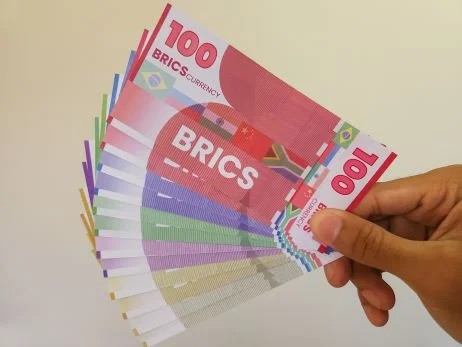India's response to the BRICS currency proposal must be guided by caution, pragmatism, and an unwavering commitment to its own economic interests

India stands at a critical juncture as the BRICS coalition flexes its economic muscle on the global stage. The latest BRICS summit in Kazan, Russia, has brought several pressing issues to the fore, none more contentious than the push for a BRICS common currency. While China and Russia have championed this cause, India remains wary, mindful of the consequences that could arise from rushing into such uncharted territory.
For India, this mantra involves carefully weighing its interests against the ambitions of its fellow BRICS members. What looks like a promising shift from the dollar-dominated financial system might just be a mirage. Grass is always greener on the other side, but India's economic stability and sovereignty must not be gambled away in the name of multipolarity.
BRICS has evolved into an economic force, representing 45% of the world’s population and accounting for nearly one-third of the global GDP. With such clout, it is no surprise that BRICS wants to break free from the stranglehold of western financial institutions like the International Monetary Fund (IMF) and the World Bank. The group's quota in the IMF has tripled, rising from 8.4% in 2001 to 25.8% in 2022, signaling its growing influence. At the same time, the G7’s quota has shrunk from 64.6% to 42.9%, underscoring a shift in global power.
Behind this impressive show of strength lie conflicting national interests. For Russia, the BRICS bloc offers a lifeline to escape Western sanctions and regain international legitimacy. Moscow, shunned by the West after its 2022 invasion of Ukraine, sees the group as a counterweight to the US-led world order. For China, BRICS represents an opportunity to extend its influence in the Global South and secure its leadership ambitions. Beijing’s efforts to drive the creation of a BRICS currency are a strategic play to solidify its position at the helm of the bloc.
India, however, has a different perspective. Unlike China and Russia, India is not interested in transforming BRICS into an anti-Western alliance. While New Delhi supports reforms that reflect the emerging multipolar world, it also values its relationships with Western nations, particularly the United States.
BRICS currency
dilemma
The idea of a BRICS currency is being pushed hard by China and Russia, with China expected to dominate any such arrangement due to its massive economic weight. As one Indian analyst pointed out, "If we look at the euro experience, the exercise was driven by Germany, the largest economy, and the Deutsche mark became more of an intervening currency." Similarly, China, as the dominant economy in BRICS, would call the shots in any currency arrangement, and the other members would have to fall in line.
This is where India’s concerns are most palpable. A BRICS currency would effectively put India’s financial sovereignty in jeopardy. The establishment of a shared currency requires a central banking system, with decisions on exchange rates and monetary policy being dictated by the dominant economy — in this case, China. If India were to face economic instability, it would find itself at the mercy of China, a position New Delhi is keen to avoid.
The creation of a common currency would also require harmonizing financial regulations, including debt-to-GDP ratios and hard currency reserves. The European Union’s experience with the euro offers a cautionary tale. Weaker economies like Greece and Portugal suffered deeply when the euro was introduced, as they were forced to adhere to strict financial regulations that stifled their ability to manage their domestic economies. BRICS, unlike the EU, is not a geographically contiguous bloc, nor does it offer the social security nets needed to cushion the economic shocks that weaker members might face.
China’s game,
India’s caution
For China, the establishment of a BRICS currency is not just about de-dollarization; it is about creating a parallel financial system that cements Beijing’s role as a global economic leader. India sees this differently. China’s dominance within the bloc would mean that the BRICS currency, in practice, would be pegged to the yuan. This would give Beijing undue leverage over the economic decisions of other BRICS members.
India’s skepticism also stems from its experience with China in other international forums. From border disputes to trade imbalances, China has never shied away from using its economic and military might to pressurize India. Allowing China to dictate the terms of a BRICS currency would be akin to handing Beijing yet another tool to manipulate its neighbours, India included.
Donald Trump has also added a new dimension to the global currency debate. Trump announced plans to impose a 100% tariff on goods from countries that stop using the US dollar in international trade.
The US dollar:
The lesser evil?
The global financial system has been dominated by the US dollar since 1944. Emerging economies have criticized this dominance, accusing the US Federal Reserve of engaging in “currency wars” that undermine other nations' economies. But replacing the US dollar with a BRICS currency under China’s control would likely replicate the same issues, if not worsen them. The US may be an imperfect partner, but it is a known quantity. China, on the other hand, is an unpredictable force, one that has repeatedly sought to undermine India’s regional and global standing.
India's response to the BRICS currency proposal must be guided by caution, pragmatism, and an unwavering commitment to its own economic interests. The stakes are too high to make decisions based on the allure of an alternative global financial order. Joining the BRICS currency initiative might seem like a step toward a multipolar world, but for India, it is a step that risks giving up too much control, too soon.